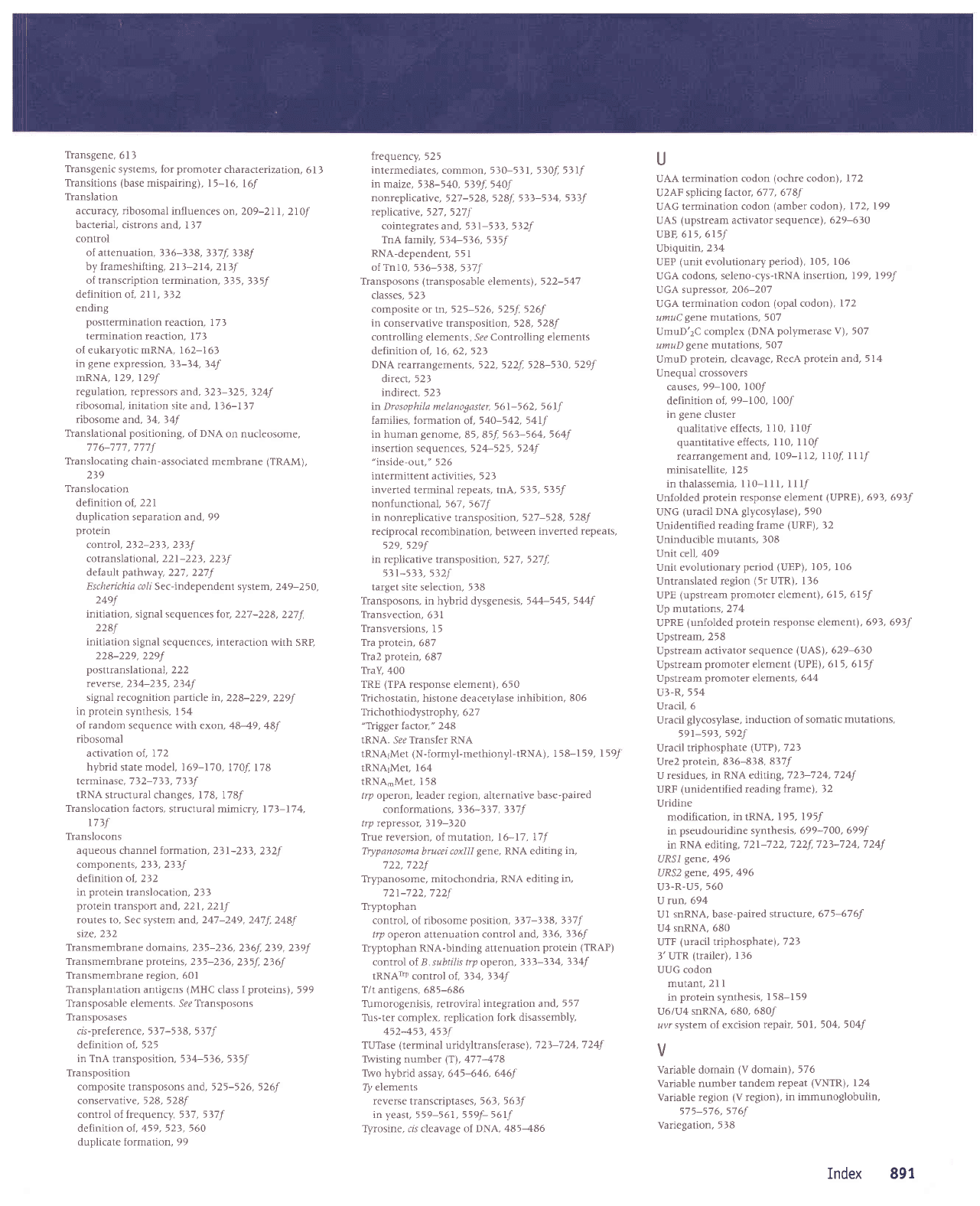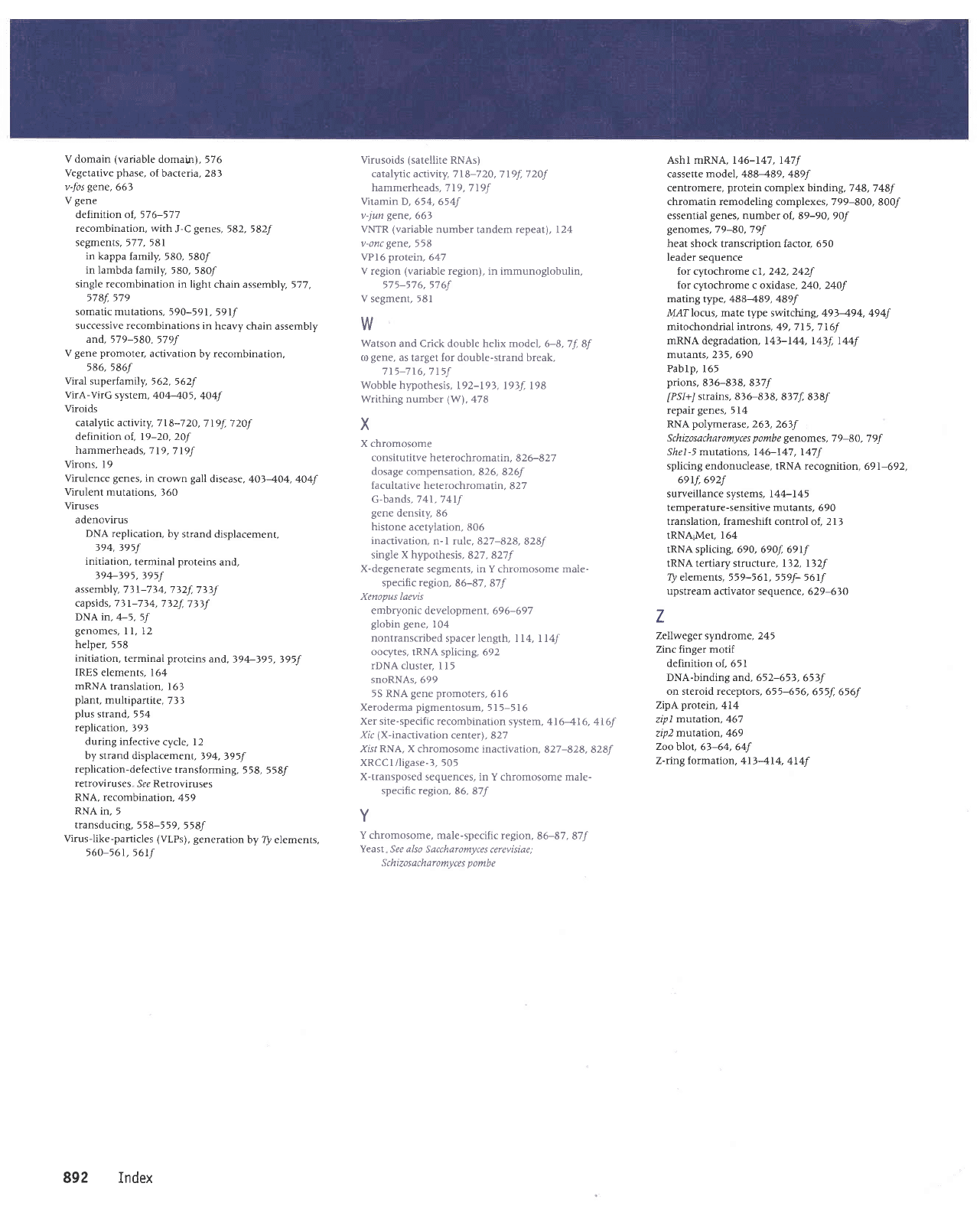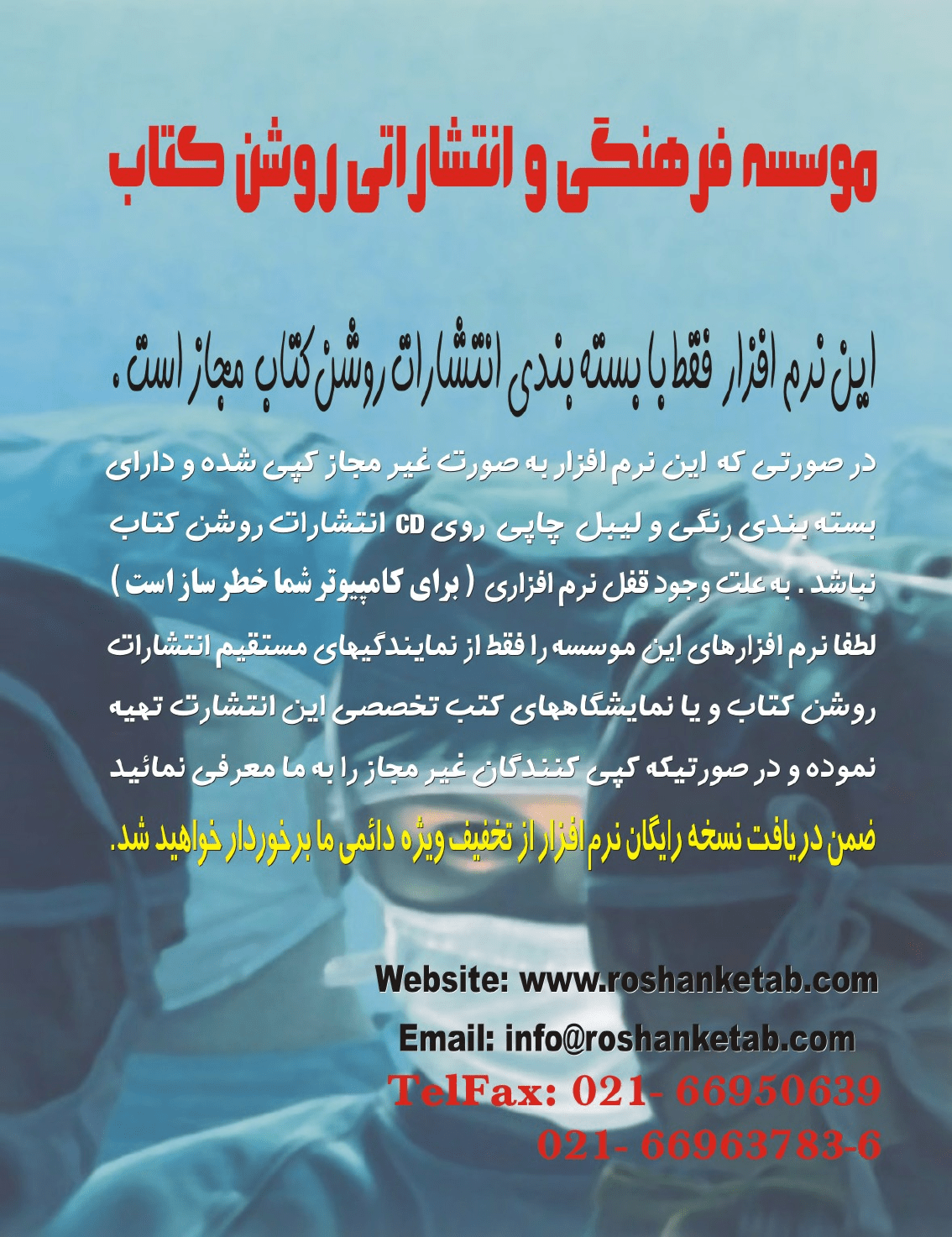Lewin Benjamin (ed.) Genes IX
Подождите немного. Документ загружается.


Transgene,
6 I l
Tfansgenic
systems, for
promoter
characterization,
6l l
Tfansitions
(base
mispairing), l5-16,
l6f
Translation
accuracy,
ribosomal influences
on, 209-211, 2I0f
bacterial,
cistrons and, I 17
control
of attenuation, )36-i)8,
3j7
f,
))8f
by frameshifting, 213-214,
2l7f
of transcription termination,
)35, ))5f
de{inition
of,
211,
}32
ending
posttermination
reaction, 1 7l
termination reaction,
l7l
of eukaryotic nRNA, I 62-1
63
in
gene
expressiorr, ))-)4, )4f
mRNA, 129, l29f
regulation, repressors
and, 32)-)25, )24f
ribosomal, initation site and,
I l6-1 l7
ribosome and, 14, 34l
Ttanslational
positioning,
of DNA
on nucleosome,
776-777,777f
Ttanslocating
chain-associated membrane
(TRAM),
2)9
Translocation
definition of, 22 I
duplication separation and, 99
protein
control
232-233, 233f
cotranslational, 22 1
-223,
22)f
default
pathway,
227, 227f
Escherichia coli
Sec-independent system, 249-250,
24ef
initiation. signal sequences f
or, 227
-228,
227
f,
228f
initiation signal sequences, interaction
with SRP,
228-229,229f
posttranslational,
222
reverce, 234-235, 2)4f
signal recognition
particle
in,
228-229,229f
in
protein
synthesis, 154
of
random
sequence with exon, 4849, 48f
ribosomal
activation of, 172
hybrid
state
model, 169-170,
1.70f,178
termlnase, / 52- / JJ, / JJI
IRNA structural changes, 178, 178/
Translocation factors,
structural mimicry, 17)-17 4,
17)f
Translocons
aqueous channel formation, 2)l-2)),
2)2f
components, 2)),21)f
deiinition of, 212
in
protein
translocation, 2ll
protein
transport and, 221, 221f
routes to, Sec system and, 247-249,
247f, 248f
srze,232
Transmembrane d
omains,
235-276,
236f, 2)9, 2)9f
Transmembrane
prcteins,
235-236,
235f, 236f
Transmembrane region, 601
Tfansplantation antigens
(MHC
class
I
proteins),
599
Transposable elements. See Transposons
Transposases
cri-pref erence, 5)7
-5)
8, 5)7
f
definition of, 525
in TnA
transposition, 53
4-53
6, 5) 5f
Transposition
composite transposons and, 525-526, 526f
conservative,
528,
r28f
control of frequency. 5)7, 5)7f
definition of,
459,
523, 560
duplicate formation, 99
frequency,525
intermediates.
common.
5 ]0-5
] l. 5)0f,
5)lf
in
maize, 538-540, 539f,540f
nonreplicative,
527
-528,
528f, 5))-r34,
5))f
replicative,
527, 527f
cointegrates
and, 531-5)3, 532f
TnA family, 5j4-536, 5)5f
RNA-dependent,
55 I
ofTnl0,536-578,5)7f
Transposons
(transposable
elements),
522-547
classes, 521
composire or rn, 525-526, 525f,526f
in
conservative transposition, 528, 528f
controlling elements See Controlling
elements
definition
of,
16,
62,52)
DNA rearrangements, 522, 522f, 528-530,
529f
diecr,52)
indirect,52l
in Drosophila
melanlgaster,
561-562, 561,f
families, formation
of, 54O-542,
54lf
in human
genome,
85, 85f,561-564,
564f
insertion
sequences, 524-525, 524f
"inside-out,"
526
intermittent activities, 52 l
inverted terminal repeats, r\A, 5)5,
5)5f
nonfunctional,
567, 567f
in nonreplicative
transposjlion,
527-528, 528f
reciprocal
recombination, between
inverted
repeats,
529,529f
in replicative transposition. 527. 5271,
53r-53),5)2f
target site selection, 518
Transposons, in hybrid dysgenesis, 544-545,
544f
Transvection,
6l I
Transversions,
l5
Tra
protein,
687
Tra2
protein,
687
TraY 400
TRE
(TPA
response element), 650
Tfichostatin,
histone deacetylase
inhibition, 806
Tf ichothiodystro
phy,
627
"Trigger
factor," 248
IRNA. See Transfer RNA
rRNArMet
(N-formyl-methionyl-IRNA), I 5 8-159,
| 591
tRNArMet, 164
tRNAmMet, 158
tlp operon, leader region, alternative
base-paired
conlormauons, St6-tJ
/,
)1
/|
,rp repressor,
319-)20
True reversion,
of
mutation, 16-1,7, 17f
Trypanosoma
brucei
coxlll
gene,
RNA editing
in,
722,722f
Tt!?anosome, mitochondria, RNA
editing in,
721-722,722f
Tfyptophan
control, of ribosome
position,
)37-)18,3)7f
lrp operon attenuation conrrol
and,,136,1)6f
Tryptophan RNA-binding attenuation
protein
(TRAP)
control
of
B subtilis trp opercn, 131-3)4,
)74f
tRNArrr control ot,334, )34J
T/t antigens, 685-686
Tumorogenisis,
retroviral
integration and,
557
Tus-ter complex, replication fork
disassembly,
45245),453f
TUTase
(terminal
uridyltransferase),
7 2)-7 24,
7 24f
Twisting number
\Tl,
477478
Two hybrid
assay, 645-646,
646f
4/
elements
rever6e transcriprases, 5 63, 5
6)f
in yeast,
559-561,
559f- 561f
fYrosine. cr cleavage of DNA,
485--486
U
UAA termination
codon
(ochre
codon), 172
U2AF splicing
factor, 677, 678f
UAG
termination codon
(amber
codonl,
172, 199
UAS
(upstream
activator sequencel,
629-6)0
uBF,615,6l5f
Ubiquitin,
214
UEP
(unit
evolutionary
period),
1 05, 1 06
UGA codons, seleno-cys-IRNA
insertion, 199, l99f
UGA supressor,
206-207
UGA termination
codon
(opal
codon),
172
umuc
gene
mttations, 507
UmuD'2C
complex
(DNA polymerase vl,
5O7
umuD
gene
morations,
507
UmuD
protein,
cleavage, RecA
protein
and, 5 l4
Unequal crossovers
causes, 99-100,
100/
definition
of, 99-100, 100/
in
gene
cluster
qualitative
effects, I
10, I I0/
quantitative
effects,
I I0, I l0/
rearrangement
and, 109-1 12,
t 101 I t 1/
minisatellite, I25
inthalassemia,
II0-f Il, f Il/
Unfolded
protein
response element
(UPRE),
69J,69Jf
UNG
(uracil
DNA
glycosylase),
590
Unidentified
reading lrame
(URF),
l2
Uninducible
mutants, 108
Unit
cell, 409
Unit evolutionary
period
(UEP),
105, 106
Untranslated region
(5r
UTR), 136
UPE
(upstream
promoter
element\, 615,615f
Up mutarions,
274
UPRE
(unfolded
protein
response element), 693, 693f
Upstream,
258
Upstream
activator sequence
\UASl,
629-6)0
Upstream
promoter
element
(UPE),
615, 615/
Upstream
promoter
elements, 644
ut-R,554
Uracil, 6
Uracil
glycosylase,
induction of somatic
mutations,
591-593,592f
Uracil triphosphate
(UTP),
721
ure2
prorein,
8)6-838,
817f
U residues, in
RNA editing, 723-724,724f
URF
(unidentified
reading
frame), 32
Uridine
modification,
in IRNA,
195, l95f
in
pseudouridine
synthesis,
699-7O0, 699f
in RNA
ediring, 721-722,722f,72j-724,
724f
URSI
gene,496
URS2
gene,495,496
u3-R-U5,
560
U run, 694
Ul
snRNA, base-paired
structure, 675-676f
U4 snRNA, 680
UTF
(uracil
triph osphatel,
7 21
l'UTR
(trailer),136
UUG codon
mutant,
2I I
in
protein
synthesis,
I58-I59
U6lU4 snRNA,
680,680f
uvr system
of excision
repair, 501, 504, 504f
V
Variable domain
(V
domain),
576
Variable
number
tandem repeat
(VNTR),
t24
variable
region
(V
region),
in immunoglobulin,
575-576,576f
Variegation,
518
Index 891

V domain
(variable
domaur),
576
Vegetarive
phas€,
of
bacteria, 281
v-fos
gene,
66)
V
gene
oellnlnonoI, >/o->/I
recombination,
with
J-C
genes,
582,
582f
segments, 577, 581
in
kappa family, 580,
580/
in lambda family,
580, 580/
single recombination in light
chain assembly,
577,
578f,579
somatic mutations,
590-591, 591/
successive recombinations
in heavy chain
assembly
and, 579-580,579f
V
gene promoter,
activation
by recombination,
586,586f
Viral
superfamily,
5 62, 5 62f
VirA-VirG
system, 4O440r,
404f
Viroids
catalytic activiry, 7 |
8-7 20, 7 l9f, 7
20f
definition of, l9-2O, 20f
hammerheads, T19,T19f
Virons,
l9
Virulence
genes,
in
crown
gall
disease. 403404,404f
Virulent
mutations, 160
Viruses
adenovirus
DNA replication,
by
strand displacement,
194, J95f
initiation,
terminal
proteins
and,
)94-)95,
395f
assembly, 7 ) l-7
34,
7
)2f, 7 ))f
capsids,
7l
I-714, 732f.71)f
DNA in,4-5,
5/
genomes,11,12
nerper, ))d
initiation,
terminal
proreins
and,
)94a95, 395f
IRES
elements, 164
mRNA
translation, l6l
plant,
muhipartite.
7ll
plus
strand, 554
replication,
393
during infective
cycle, l2
by strand displacement.
)94,395f
replication-defective
transf
orming,
5 5 8, i 58f
retroviruses
Se€ Retroviruses
RNA, recombinalion,
459
RNA in, 5
rransoucrng,
> t6-> t9, >
> aJ
Virus-like-particles
(VLPs),
generation
by
7y
elements,
560-56r,56tf
Virusoids
(satellite
RNAS)
catalyric activiry, 7 l8-720,
7 19f,
720f
hammerheads, 719,719f
Vitamin
D, 654,654f
v-1un
gene,663
VNTR
(variable
number
tandem repeatl, 124
v-onc
gene,
r58
VPl6
protein,647
V
region
(variable
region), in immunoglobulin,
575-576,576f
V
segment, 581
W
Watson
and Crick double helix model, 6-8,7f,8f
O
gene,
as target for double-strand break,
7 t5-7 t6, 7
trf
Wobble hypothesis,
192-19), 1.9)f, 198
Writhing number
(Wl,
47
I
X
X chromosome
consitutitve heterochromatin,
826-827
dosage compensation,
826, 826f
facultative heterochromatin,
827
G-bands,
741,741f
gene
density, 86
histone
acetylation, 806
inactivation,
n- l rule, 827
-828,
828f
single
X
hypothesis, 827,827f
X-degenerate
segments, in Y chromosome male-
specific
region,
86-87, 87f
Xenopus laevis
embryonic development,
69 6-697
globin gene,
104
nontranscribed
spacer Iength, lI4, l l,4f
oocytes, IRNA splicing, 692
rDNA cluster,
I l5
snoRNAs, 699
55 RNA
gene promoters,
616
Xeroderma
pigmentosum,
5l 5-516
Xer site-specific recombination
system, 416416, 416f
Xrc
(X-inactivation
center),
827
Xrt RNA, X
chromosome inactivation,
827-828, 828f
XRCCI/ligase-3,505
X-transposed
sequences, in Y chromosome male-
specific region,
86, 87/
Y
Y chromosome,
male-specific region,
86-87, 87f
Yeast
See also Saccharomyces
cerevisiae:
S c hizo
s
acha r
omy ce s
p
o m b e
AshI nRNA, 146-147, l47f
cassette
model, 488489,
489f
centromere,
protein
complex bindir\g, 7
48, 7 48f
chromatin remodeling complexes, 799-800,
800/
essential
genes,
number of, 89-90,90f
genomes,
79-80,79f
heat shock transcription factor. 650
leader
sequence
for cytochrome cl, 242, 242f
for cytochrome c oxidase, 24o,24of
mating type, 488489, 489f
M-4Tlocus, mate type switching, 49)494,494f
mitochondrial introns, 49, 7 15, 7 16f
mRNA degradation, 14)-144, l4)f, I44f
mutants, 275,690
PabIp,165
prions,
836-838, 817
IPSI+/
strains, 836-818,
8J7
f,
838f
repair
genes,
5 l4
RNA
polymerase,
263, 26)f
Schizosacharomyces
pombe genomes,
7 9-8O, 7 9f
S/r,el
-5
mutations, 146-147
,
l47f
splicing endonuclease, IRNA recognilion,
691-692,
6erf,6e2f
surveillance systems, l44l-l 45
temperature-sensitive mutants,
690
translation, frameshift control
of, 2
I
l
tRNAiMet, I64
IRNA splicing, 690, 690f, 69tf
IRNA tertiary strxcl.ule, l)2, l32f
D/
elements, 559-561,559f- 56tf
upstream
activator sequence, 629-630
7
Zellweger syndrome, 245
7i^- fi---. -^+if
lIrL lut!r rrrvrrr
definition of, 651
DNA-binding and, 652-653,
653f
on steroid receptors, 655-656,
655f, 656f
ZipA
prorein,
414
Tikl mnr^tian 447
zip2
mlrarion, 469
Zoo
blot, 67-64, 64f
Z-ring formation, 413414,
414f
892 Index

